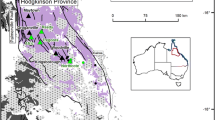Abstract
Estimates of numbers of mineral deposits are fundamental to assessing undiscovered mineral resources. Just as frequencies of grades and tonnages of well-explored deposits can be used to represent the grades and tonnages of undiscovered deposits, the density of deposits (deposits/area) in well-explored control areas can serve to represent the number of deposits. Empirical evidence presented here indicates that the processes affecting the number and quantity of resources in geological settings are very general across many types of mineral deposits. For podiform chromite, porphyry copper, and volcanogenic massive sulfide deposit types, the size of tract that geologically could contain the deposits is an excellent predictor of the total number of deposits. The number of mineral deposits is also proportional to the type’s size. The total amount of mineralized rock is also proportional to size of the permissive area and the median deposit type’s size. Regressions using these variables provide a means to estimate the density of deposits and the total amount of mineralization. These powerful estimators are based on analysis of ten different types of mineral deposits (Climax Mo, Cuban Mn, Cyprus massive sulfide, Franciscan Mn, kuroko massive sulfide, low-sulfide quartz-Au vein, placer Au, podiform Cr, porphyry Cu, and W vein) from 108 permissive control tracts around the world therefore generalizing across deposit types. Despite the diverse and complex geological settings of deposit types studied here, the relationships observed indicate universal controls on the accumulation and preservation of mineral resources that operate across all scales. The strength of the relationships (R 2=0.91 for density and 0.95 for mineralized rock) argues for their broad use. Deposit densities can now be used to provide a guideline for expert judgment or used directly for estimating the number of most kinds of mineral deposits.
Similar content being viewed by others
References
Aitchison J, Brown JAC (1963) The lognormal distribution. Cambridge University Press, Cambridge, 176 p
Albers JP (1986) Descriptive model of podiform chromite. In: Cox DP, Singer DA (eds) Mineral deposit models. US Geological Survey Bulletin 1693, p 34
Allais M (1957) Method of appraising economic prospects of mining exploration over large territories—Algerian Sahara case study. Manag Sci 3:285–345
Bliss JD, Menzie WD (1993) Spatial mineral-deposit models and the prediction of undiscovered mineral deposits. In: Kirkham RV, Sinclair WD, Thorpe RI, Duke JM (eds) Mineral deposit modeling. Geological Association Canada Special Paper 40, pp 693–706
Bliss JO (2007) Personal communication
Brinck JW (1967) Note on the distribution and predictability of mineral resources. Euratom 3461, Brussels, 25 p
Cox DP, Barton PR, Singer DA (1986) Introduction. In: Cox DP, Singer DA (eds) Mineral deposit models. US Geological Survey Bulletin 1693, pp 1–10
Cunningham CG et al (2007) Quantitative mineral resource assessment of undiscovered porphyry copper deposits in South America. US Geological Survey, Open-File Report 2007-XX, 204 p (in press)
Henley RW, Berger BR (2000) Self-ordering and complexity in epizonal mineral deposits. Annu Rev Earth Planet Sci 28:669–719
Lisitsin V, Olshina A, Moore DH, Willman CE (2007) Assessment of undiscovered mesozonal orogenic gold endowment under cover in the northern part of the Bendigo Zone. GeoScience Victoria Gold Undercover Report 2, Department of Primary Industries, 98 p, www.dpi.vic.gov.au/minpet/store
Matheron G (1959) Remarques sur la loi de Lasky. Chron Mines O-M Rech Min, 27e annee 282:463–465
Mosier DL, Page NJ (1988) Descriptive and grade-tonnage models of volcanogenic manganese deposits in ocean environments—a modification. US Geological Survey Bulletin 1811, 28 p
Mosier DL, Singer DA, Berger VI (2007) Volcanogenic massive sulfide deposit density. US Geological Survey Scientific Investigations Report 2007-5082, 21 p, http://pubs.usgs.gov/sir/2007/5082/
Razumovsky NK (1940) Distribution of metal values in ore deposits. CR (Dokl) Acad Sci URSS 9:814–816
Singer DA (1993) Basic concepts in three-part quantitative assessments of undiscovered mineral resources. Nonrenew Resour 2(2):69–81
Singer DA (1994) Conditional estimates of the number of podiform chromite deposits. Nonrenew Res 3(3):200–204
Singer DA, Menzie WD Map scale effects on estimating the number of undiscovered mineral deposits. In: Qiuming C and Graeme B-C (eds) 40 years progress in mathematical geology. Elsevier, Amsterdam, 19 p (in press)
Singer DA, Menzie WD, Sutphin D, Mosier DL, Bliss JD (2001) Mineral deposit density—an update. In: Schulz KJ (ed) Contributions to global mineral resource assessment research. US Geological Survey Professional Paper 1640-A, A1–A13. (Also available online at http://pubs.usgs.gov/prof/p1640a/)
Singer DA, Berger VI, Menzie WD, Berger BR (2005) Porphyry copper density. Econ Geol 100(3):491–514
Author information
Authors and Affiliations
Corresponding author
Rights and permissions
About this article
Cite this article
Singer, D.A. Mineral Deposit Densities for Estimating Mineral Resources. Math Geosci 40, 33–46 (2008). https://doi.org/10.1007/s11004-007-9127-3
Received:
Accepted:
Published:
Issue Date:
DOI: https://doi.org/10.1007/s11004-007-9127-3




